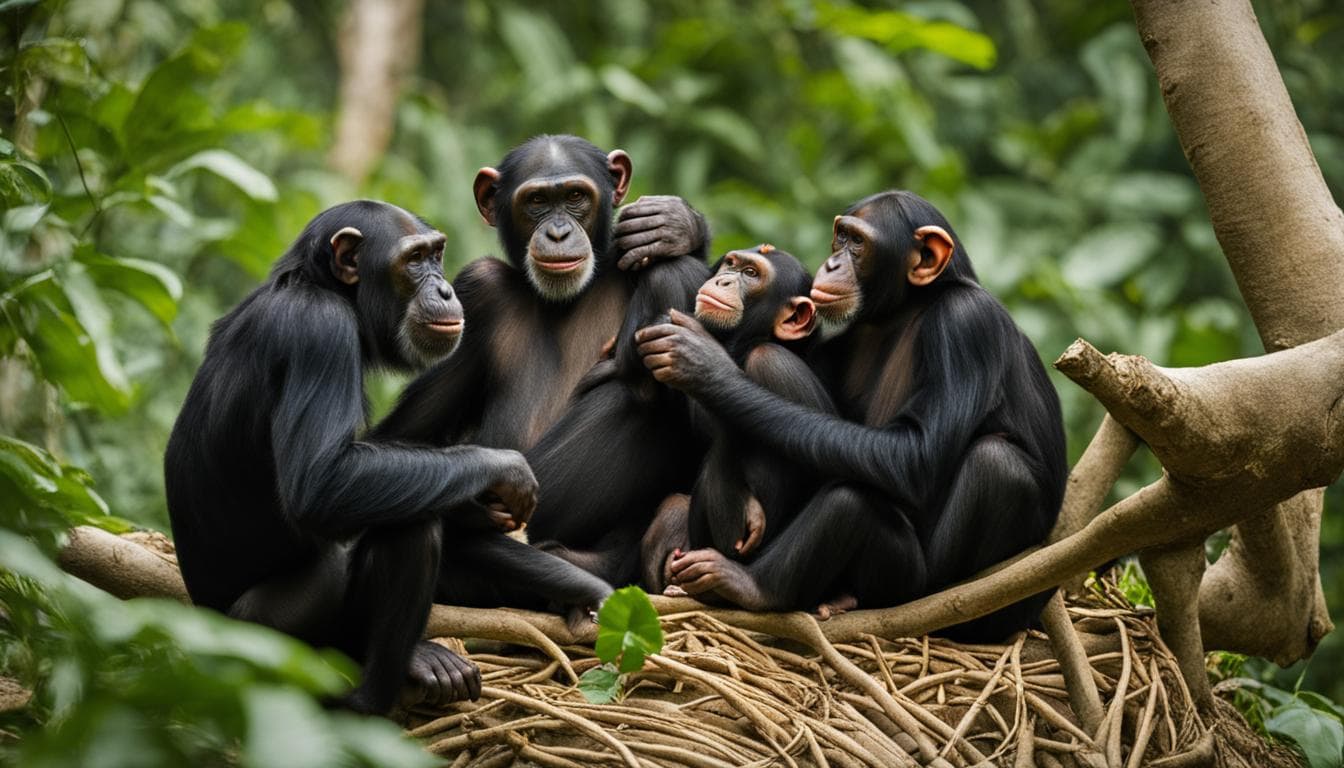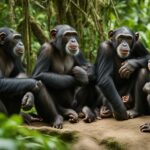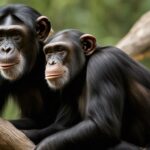Welcome to our exploration of chimpanzee family bonds, their social structure, and the fascinating dynamics that exist within these primate communities. Chimpanzees, known for their intelligence and complex behaviors, live in extended family groups ranging from 20 to 120 individuals. These family relationships are crucial for their survival, providing support, protection, and a sense of belonging.
Unlike humans, chimpanzees have a fission-fusion social organization, where they form smaller groups that periodically come together. Within these groups, female chimpanzees play a central role in the care and upbringing of their offspring. Mothers and sons often develop lifelong bonds, as do other individuals within the extended social group.
Chimpanzees exhibit remarkable social behaviors that hint at the presence of a basic form of culture. They learn from each other and engage in touching and grooming to build deep bonds and calm tensions within the group. This type of communication and cooperation is essential for their survival and overall well-being.
In this article, we will delve deeper into the importance of family bonds in chimpanzees, explore their social hierarchy, examine their family dynamics and behavior, and uncover fascinating aspects of their family life and reproduction. We will also discuss the recognition of family resemblance in chimpanzees and its significance for their social interactions.
Join us on this captivating journey into the world of chimpanzee family bonds and gain insights into primate family dynamics that may offer a deeper understanding of our own social relationships.
The importance of family bonds in chimpanzees
Family bonds play a crucial role in the social cohesion and survival of chimpanzee groups. Just like humans, chimpanzees rely on their families for emotional support, learning, and collaboration in various activities. Mothers are particularly important in nurturing and teaching their young, and they often develop lifelong bonds with their sons. In cases where a mother becomes ill or dies, other females or older siblings step in to care for the orphaned infants, highlighting the strong sense of kinship within the group.
These close relationships and support within a family group provide both emotional and physical protection for individuals. Chimpanzees depend on their families for social interaction, which helps them learn important behaviors and cultural practices from each other. Additionally, the strength of family bonds contributes to the overall stability and well-being of chimpanzee communities, allowing them to thrive in their natural habitats.
Research has shown that family bonds are not only vital for individual chimpanzees but also for the overall functioning of the group. The formation of alliances and the establishment of a social hierarchy within the group contribute to group cohesion and cooperation. By recognizing and respecting the hierarchy, chimpanzees maintain order and minimize conflicts. The recognition of family resemblance and kinship signals further enhances social dynamics and facilitates the formation of alliances.
The importance of family bonds in chimpanzees underscores the significance of social relationships in primate communities. Studying chimpanzee family dynamics provides valuable insights into the nature of social interactions and can help us better understand human relationships as well.
Table: Chimpanzee Family Bonds and Social Cohesion
| Family Bonds | Impact |
|---|---|
| Nurturing and teaching by mothers | Facilitates learning and development of young chimpanzees |
| Lifelong bonds between mothers and sons | Provides emotional support and protection for male offspring |
| Support from other females and older siblings | Ensures care for orphaned infants |
| Social interaction within family groups | Facilitates learning and cultural transmission |
| Formation of alliances and social hierarchy | Promotes group cohesion and cooperation |
Social Hierarchy Among Chimpanzee Families
Chimpanzee groups have a well-defined social hierarchy that contributes to their overall functioning and group cohesion. At the top of the hierarchy is the dominant male, followed by adult females, subordinate males, and juveniles. Dominance relationships among males are influenced by alliances, with males forming coalitions to defend their territory against intruding males. This social order helps maintain stability and cooperation within the group.
Acknowledgment and respect for the hierarchy are crucial in chimpanzee society. Chimpanzees understand and adhere to the social order, defending their territory against trespassing males. This recognition of social hierarchy ensures the maintenance of group cohesion and fosters cooperation in various activities such as foraging and hunting.
Group bonding is an integral part of chimpanzee family dynamics and plays a significant role in the stability and functioning of their social groups. The formation of alliances and the establishment of social order contribute to the overall cohesion and cooperation within chimpanzee families.
| Chimpanzee Social Hierarchy | Role |
|---|---|
| Dominant Male | At the top of the hierarchy, the dominant male holds the highest rank and has preferential access to resources. |
| Adult Females | Adult females have a high rank and play a critical role in nurturing and raising offspring. |
| Subordinate Males | Subordinate males are lower in rank and often form alliances to protect their territory. |
| Juveniles | Juveniles are at the bottom of the hierarchy and learn from their elders. |
Chimpanzee Family Dynamics and Behavior
Chimpanzees, our close primate relatives, exhibit fascinating behavioral patterns within their family groups. These behaviors contribute to the formation of strong social relationships and are crucial for the overall functioning and well-being of chimpanzee communities. By observing their interactions, we gain valuable insights into their complex family dynamics and the importance of family bonds.
Chimpanzees communicate through a rich repertoire of calls and vocal expressions, which enable them to convey various messages to other group members. These vocalizations serve as a form of language and allow chimps to signal the presence of food, potential danger, or even their emotional states. These forms of communication help maintain social cohesion within the group and facilitate cooperation in activities such as foraging and hunting.
In addition to vocal communication, chimpanzees also engage in physical behaviors to build and maintain social relationships. Touching, grooming, and embracing are essential for bonding and calming tensions within the group. Through these physical interactions, chimpanzees establish and strengthen their connections, similar to how humans engage in physical affection to express love and care.
Furthermore, chimpanzees display a wide range of behaviors that hint at the presence of a simple form of culture within their communities. They learn from each other through observation and imitation, and have been observed using tools for various purposes, such as cracking open nuts or fishing insects out of tree trunks. These behaviors, passed down from one generation to the next, contribute to the transmission of knowledge and skills within the chimpanzee group.
Chimpanzee Social Relationships
Chimpanzee social relationships are intricate and dynamic. They form hierarchical structures within their groups, with dominant males, adult females, subordinate males, and juveniles. These dominance relationships are influenced by alliances, and males may form coalitions to defend their territory from intruding males.
The social structure of chimpanzees is not only based on dominance but also on cooperation and collaboration. Group bonding plays a crucial role in maintaining stability and cohesion within the chimpanzee family. By forming strong social bonds, chimpanzees establish trust and support, which in turn helps them navigate challenges and secure resources.
The study of chimpanzee family dynamics and behavior provides us with fascinating insights into the intricate social lives of our primate relatives. By understanding these complex relationships, we can gain a deeper appreciation for the importance of family bonds and social cohesion in both human and non-human primates.
Chimpanzee Family Life and Reproduction
In the world of chimpanzees, family plays a central role in their lives. Mothers and offspring form strong bonds, ensuring the survival and development of the young. Chimpanzee mothers typically give birth once every five years, and during this time, they provide care and nurture to their infants. If unfortunate circumstances occur, such as the mother becoming injured or dying, other females within the group step in to care for the orphaned infant.
The bond between a mother and her offspring is lifelong, with infants remaining close to their mothers for the first decade of their lives. It is fascinating to observe how chimpanzee mothers teach their young essential skills for survival, such as foraging for food and social interactions. The close relationship between mothers and their offspring allows the transmission of knowledge and cultural practices within the chimpanzee community.
While males typically stay in their natal group, females may migrate to neighboring communities or return to their natal group after mating. This movement helps maintain genetic diversity within chimpanzee populations. However, reproduction rates are slow, with mothers typically having only about three children in their lifetime. This slow reproductive rate emphasizes the importance of family bonds and the need for strong social relationships within chimpanzee communities.

Table: Chimpanzee Reproduction and Family Life
| Aspect | Details |
|---|---|
| Reproductive Rate | Chimpanzee mothers typically give birth once every five years. |
| Mother-Infant Bond | Mothers provide care and nurture to their infants, and the bond between them is lifelong. |
| Orphaned Infants | If a mother becomes injured or dies, other females within the group will step in to care for the orphaned infant. |
| Movement of Females | Females may migrate to neighboring communities or return to their natal group after mating. |
| Genetic Diversity | The movement of females helps maintain genetic diversity within chimpanzee populations. |
In summary, chimpanzee family life is characterized by strong bonds between mothers and offspring. These relationships are crucial for the survival and development of young chimpanzees. The slow reproductive rate emphasizes the importance of maintaining strong social connections within chimpanzee communities. Understanding the dynamics of chimpanzee family life provides valuable insights into primate behavior and the significance of family bonds in both human and non-human primates.
Chimpanzee Family Resemblance and Recognition
Research has revealed fascinating insights into the visual kinship recognition capabilities of chimpanzees within their family groups. Similar to humans, chimpanzees exhibit a resemblance between family members, particularly in their facial features. This resemblance serves as a potential cue for recognizing family relationships, facilitating social interactions and alliances within the group.
However, the accuracy of recognizing family resemblance in chimpanzees varies depending on various factors. For instance, adult family pairs are easier to recognize than very young infants. This suggests that recognition abilities develop and refine over time, indicating the significance of experience and exposure in kinship recognition.
“The resemblance between family members in chimpanzee groups is not merely coincidental but serves as a mechanism for identifying and strengthening family ties,” says Dr. Jane Goodall, a renowned primatologist and chimpanzee expert.
The cognitive abilities of chimpanzees, coupled with their social dynamics, contribute to their recognition of family resemblance. This recognition allows young chimpanzees to seek support and establish relationships with relatives, fostering group cohesion and cooperation.
Table: Chimpanzee Family Resemblance
| Age Group | Recognition Accuracy |
|---|---|
| Newborns and infants | Low |
| Juveniles | Moderate |
| Adults | High |
Note: Recognition accuracy is influenced by various factors such as age and familiarity within the group.
Conclusion
Chimpanzees exhibit complex family dynamics and build strong bonds within their social groups. Family relationships are vital for their social cohesion, survival, and well-being. The formation of alliances, the establishment of social hierarchy, and the recognition of family resemblance contribute to the stability and functioning of chimpanzee families.
The study of chimpanzee family bonds provides valuable insights into primate family dynamics and helps us understand the importance of social relationships in both human and non-human primates. Chimpanzees rely on their families for emotional support, learning, and collaboration in various activities. By observing their behavior, communication, and interactions, researchers gain a deeper understanding of the role of family bonds in maintaining the stability and well-being of chimpanzee communities.
From the nurturing and lifelong bonds between mothers and offspring to the complex social hierarchy and the recognition of family resemblance, chimpanzees demonstrate the significance of family in their lives. As we continue to study and learn from these incredible creatures, we gain valuable insights into our own human family dynamics and the importance of social connections in shaping our lives.
What are the similarities and differences in family bonds and relationships between chimpanzees and humans?
Chimpanzees, like humans, have strong family relationships in chimpanzee groups. Both species form close bonds with their family members and rely on them for support and protection. However, the way they communicate and interact within their family units can differ, with humans relying more on verbal communication and chimps utilizing physical cues and gestures.
FAQ
How do chimpanzee family bonds work?
Chimpanzees live in extended family groups and have close relationships with related individuals. They form deep bonds through touching and grooming, which helps build social cohesion and calm tensions within the group.
How often do female chimpanzees give birth?
Female chimpanzees typically give birth once every five years. They have close relationships with related females and older siblings who often share in the care of their infants.
Do chimpanzees form lifelong bonds?
Yes, chimpanzees form lifelong bonds with individuals within their extended social group. Mothers and sons, as well as other individuals, have long-lasting relationships that contribute to the stability and well-being of chimpanzee communities.
What is the role of mothers in chimpanzee families?
Mothers play a vital role in nurturing and teaching their young. They provide care and nurture to their infants, and if a mother becomes injured or dies, other females in the group may step in to care for the orphaned infant.
How do chimpanzee groups establish social order?
Chimpanzee groups have a social hierarchy with a dominant male, adult females, subordinate males, and juveniles. Dominance relationships are influenced by alliances, and males may form coalitions to defend their territory.
What are some behaviors exhibited by chimpanzees within their family groups?
Chimpanzees communicate through a rich language of calls and vocal expressions. They learn from each other, use tools, and engage in behaviors such as touching, grooming, and embracing to build deep bonding and maintain social relationships within the group.
How does chimpanzee reproduction occur?
Chimpanzee mothers typically give birth only once every five years and have an intimate relationship with their offspring. Males usually stay in their natal group, while females may migrate to neighboring communities or return to their natal group after mating.
Do chimpanzees recognize family resemblance?
Research has shown that there is a resemblance between family members in chimpanzee groups, indicating a potential recognition of family relationships. This recognition of kinship signals may be beneficial for young chimpanzees as they seek support and form alliances within the group.










